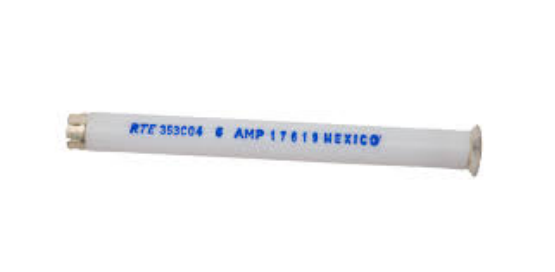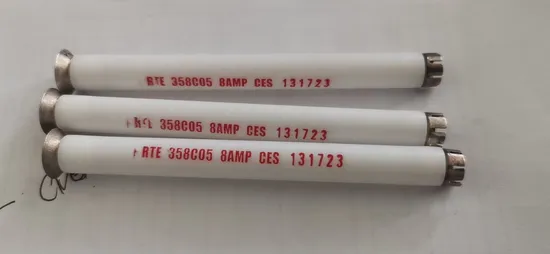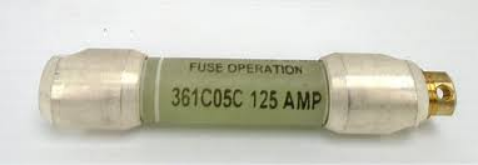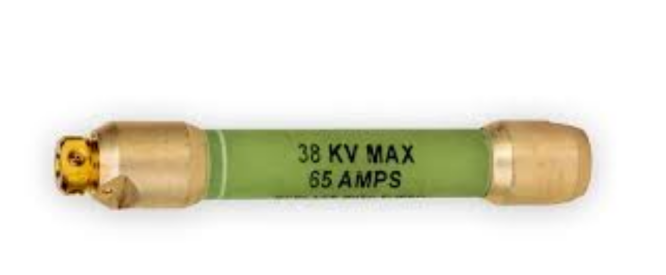What is a Bayonet Fuse?
A bayonet fuse is a type of fuse commonly used in automotive and industrial applications. The name “bayonet” refers to the way the fuse is mounted and secured into a fuse holder: it’s inserted into a socket and then rotated or “twisted” to lock it in place, much like a bayonet fits into the muzzle of a rifle.
Eaton’s Cooper Poweseries Bay-O-Net fuse offers a protection package for single- and three-phase transformers. The assembly combines the ease of hotstick operation with the safety of deadfront construction and is used with an isolation link to prevent line personnel from closing into a fault when replacing a blown Bay-O-Net link.

Types of Bayonet Fuses:
The Eaton Cooper power system Bayonet fuse is mainly divided into the following types: current sensing, dual sensing, dual element, high amp, and 38kV. The specific type of fuse used depends on the capacity, voltage, current, number of phases, and purpose of the transformer. This article will specifically introduce the differences and characteristics between fuses.
1.Current Sensing Bay-O-Net Fuse
The current sensing BON fuse is a main accessory of the overcurrent protection device of the oil-immersed padmount transformer in the power distribution system. It is used t o isolate the fault current to protect the equipment, or to isolate the faulty equipment to protect the power system. It can be used for single-phase transformers, self-protected transformers or other distribution equipment not exceeding 500kVA, and can also be u sed for three-phase transformers not exceeding 1500kVA.
Overcurrent protection fuses are generally used in conjunction with backup fuses (ie ELSP) to form a “two-stage protection” scheme in which the current sensing fuse and th e backup fuse are connected in series. The current sensing fuse performs overload pro tection and secondary side protection, and the backup protection fuse is
used to dry pr otect the internal fault of the transformer (coil short circuit fault, etc.).
The current sensi ng fuse is installed in a plug-in fuse barrel, which is very convenient to replace, simple t o install and reliable in operation. Therefore, it is widely used for high-voltage side prot ection of ANSI Padmount transformers.

Electrical Ratings and Characteristics
| Voltage(KV) | Catalog No. | Maximum Single-Phase Interrupting Rating | |||
| Cover-Mounted Assembly | Sidewall-Mounted Assembly | ||||
| Mineral Oil | Mineral Oil | FR3 Oil | |||
| 8.3 | 353C04-C08 | 3500A | 3500A | 3500A | |
| 353C10-C12 | 3500A | 3500A | 2500A | ||
| 353C14-C17 | 3500A | 3500A | 3500A | ||
| 15.5 | 353C04-C08 | 2500A | 2500A | 2500A | |
| 353C10-C12 | 2500A | 2500A | 1500A | ||
| 353C14-C17 | 2500A | 2500A | 2500A | ||
| 23 | 353C04-C17 | 1000A | 1000A | 1000A | |
Ordering information
| Continuous Current Rating (A) | Catalog No. |
| 6 | 4000353C04B |
| 10 | 4000353C06B |
| 15 | 4000353C08B |
| 25 | 4000353C10B |
| 40 | 4000353C12B |
| 65 | 4000353C14B |
| 100 | 4000353C16B |
| 140 | 4000353C17B |
*Add suffix “B” to order individual fuse; add “M” to order bag of 50
2.Dual Sensing Bay-O-Net Fuse
The dual sensing fuse is a main accessory for overcurrent protection of oil-immersed padmount transformers in power distribution systems. It is used in conjunction with the backup fuse (i.e. ELSP) to form a “two-stage protection solution”. The dual sensing fuse protects the low-voltage side of the transformer from faults or overloads in terms of current and temperature, and can prevent the transformer from heating up for a long time due to overload or ambient temperature. The dual sensing fuse is installed in a plug-in fuse barrel, which is easy to replace, simple to install and reliable in operation. Therefore, it is widely used for high-voltage side protection of American padmount transformers.

Electrical Ratings and Characteristics
| Voltage(KV) | Catalog No. | Maximum Single-Phase Interrupting Rating | ||||
| Cover-Mounted Assembly | Sidewall-Mounted Assembly | |||||
| Mineral Oil | Mineral Oil | FR3 Oil | ||||
| 4.16 | 358C03-C14 | 3500A | 3500A | 3500A | ||
| 358C16-C18 | 3500A | 3500A | 2000A | |||
| 8.3 | 358C03-C08 | 3500A | 3500A | 3500A | ||
| 358C10-C12 | 3500A | 3500A | 2500A | |||
| 358C14 | 3500A | 3500A | 1500A | |||
| 358C16-C18 | 3500A | 3500A | 1200A | |||
| 15.5 | 358C03-C08 | 2500A | 2500A | 2500A | ||
| 358C10-C12 | 2500A | 2500A | 1500A | |||
| 358C14 | 2500A | 2500A | 1000A | |||
| 358C16-C18 | ** | ** | ** | |||
| 23 | 358C03-C08 | 1000A | 1000A | 1000A | ||
| 358C10-C12 | 1000A | 600A | 600A | |||
| 358C14 | ** | 600A | 600A | |||
| 358C16-C18 | ** | ** | ** | |||
**Not suitable for this voltage
Ordering information
| Continuous Current Rating (A) | Catalog No. |
| 3 | 4000358C03B |
| 8 | 4000358C05B |
| 15 | 4000358C08B |
| 25 | 4000358C10B |
| 50 | 4000358C12B |
| 65 | 4000358C14B |
| 100 | 4000358C16B |
| 140 | 4000358C18B |
*Add suffix “B” to order individual fuse; add “M” to order bag of 50
3.Dual Element Bay-O-Net Fuse
The dual element fuse is a major accessory for overcurrent protection of oil-immersed padmount transformers in power distribution systems. It is used in series with the backup fuse ) to form a “two-stage protection” solution. The dual element fuse protects the transformer from faults or overloads on the low-voltage side from both current and temperature aspects. The backup p fuse is used to protect the transformer from internal faults (coil short-circuit faults, etc.). The standard ampere-second curve can accurately match the upper and lower fuses and circuit breakers. The dual element fuse is installed in the fuse barrel, which is easy to replace, simple to install and reliable in operation. Therefore, it is widely used for high-voltage side protection of American padmount transformers.

Electrical Ratings and Characteristics
| Voltage(KV) | Catalog No. | Maximum Single-Phase Interrupting Rating | |||
| Cover-Mounted Assembly | Sidewall-Mounted Assembly | ||||
| Mineral Oil | Mineral Oil | FR3 Oil | |||
| 8.3 | 108C03-C14 | 3500A | 3500A | 3500A | |
| 15.5 | 108C03-C12 | 2500A | 2500A | 2500A | |
| 108C14 | 2500A | 2500A | 2000A | ||
| 23 | 108C03-C04 | 1000A | 1000A | 1000A | |
| 108C05-C07 | ** | 1000A | 1000A | ||
| 108C09-C14 | ** | ** | ** | ||
Ordering information
| Continuous Current Rating (A) | Catalog No. |
| 5 | 4038108C03B |
| 6 | 4038108C04B |
| 8 | 4038108C05B |
| 12 | 4038108C06B |
| 15 | 4038108C07B |
| 25 | 4038108C09B |
| 40 | 4038108C11B |
| 50 | 4038108C12B |
| 65 | 4038108C14B |
*Add suffix “B” to order individual fuse; add “M” to order bag of 50
4.High ampere overload Bay-O-Net fuse
Eaton’s Cooper Power™ Series high overload fuses are used to protect power distribution equipment from damaging currents and to protect distribution systems from equipment failures. The fuses are installed in Eaton’s Cooper Power Series Bay-O-Net silver-plated fuse holder. High overload fuses provide better heat dissipation when used at higher load currents. The lower operating temperature allows the Bay-O-Net fuse protection program to be expanded to protect larger capacity transformers.

Electrical Ratings and Characteristics
| Voltage(KV) | Catalog No. | Maximum Single-Phase Interrupting Rating | |
| Sidewall-Mounted Assembly | |||
| Mineral Oil | FR3 Oil | ||
| 8.3 | 361C03-C05 | 3500A | 2000A |
| 15.5 | 361C03-C05 | 2500A | 2500A |
| 23 | 361C03-C05 | ** | ** |
**Not suitable for this voltage
Ordering information
| Continuous Current Rating (A) | Continuous Current Rating at 25°C* | Catalog No. |
| 65 | 135 | 4038361C03CB |
| 100 | 165 | 4038361C04CB |
| 125 | 185 | 4038361C05CB |
| Shorting Bar (Solid link) | 200 | 4038361C10CB |
5.38kV Bay-O-Net fuse
Eaton’s Cooper Power™ Series 38kV fuses are used to protect power distribution equipment from damaging currents and to protect distribution systems from equipment failures. The fuses are installed in Eaton’s Cooper Power Series 38kV Bay-O-Net silver-plated fuse holder (see Bay-O-Net Fuse Holder).

Electrical Ratings and Characteristics
| Voltage(KV) | Catalog No. | Maximum Single-Phase Interrupting Rating | |
| Sidewall-Mounted Assembly | |||
| Mineral Oil | FR3 Oil | ||
| 38 | 380C06-C12 | 900A | 900A |
| 380C14 | 1000A | 1000A | |
| 34.5 | 380C16-C17 | 1200A | 1200A |
Ordering information
| Current (A) | Catalog No. |
| 10 | 4000380C06CB |
| 15 | 4000380C08CB |
| 25 | 4000380C10CB |
| 30 | 4000380C11CB |
| 40 | 4000380C12CB |
| 65 | 4000380C14CB |
| 80 | 4000380C16CBCN |
| 120 | 4000380C17CBCN* |
| 120 | 4000380C17CBCNP* |
* C17CBCN is suitable for transformer protection up to 5MVA,
C17CBCNP is suitable for transformer protection up to 5.2MVA
The design is simple, but effective, making bayonet fuses a reliable choice for safety in both low- and high-voltage circuits.